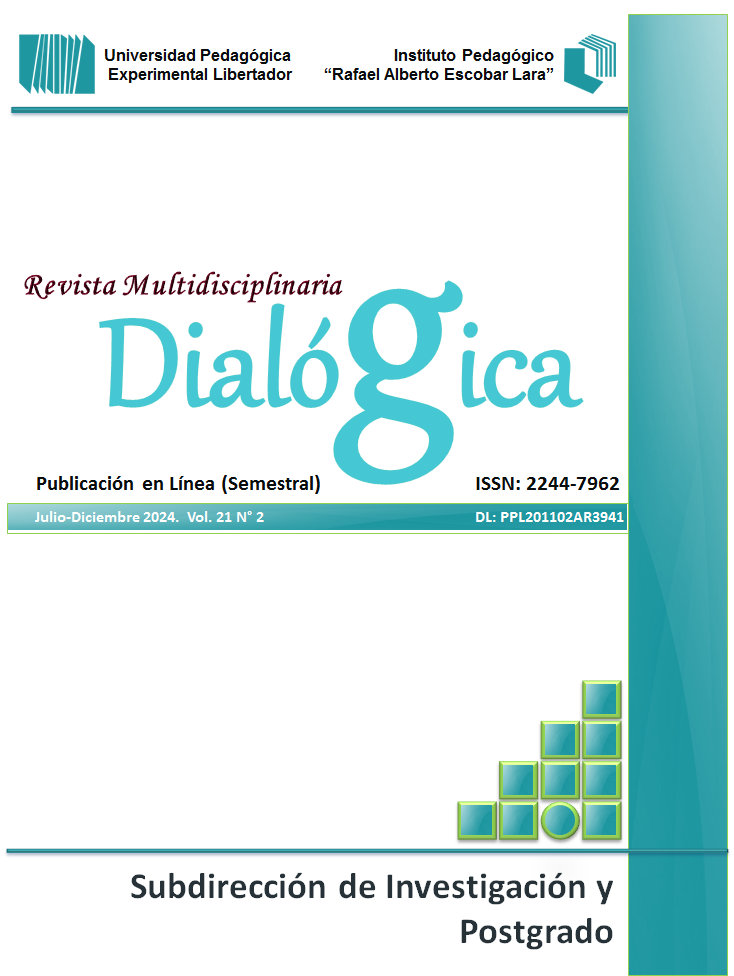DESAFÍOS Y ESTRATEGIAS DE SEGURIDAD DIGITAL PARA COMBATIR LA CIBERCRIMINALIDAD EN EL PERÚ
DOI:
https://doi.org/10.56219/dialgica.v21i2.3327Palabras clave:
Legislación cibernética, brecha digital, alfabetización digital, cibercriminalidadResumen
En la actualidad, la cibercriminalidad se ha convertido en un problema apremiante en Perú, afectando a ciudadanos, empresas y gobiernos por igual. Las diversas formas en las que se pueden cometer delitos informáticos requieren una revisión de los desafíos que estos representan para pensar en las estrategias de seguridad que se pueden implementar. Esta investigación consistió en revisar sistemáticamente documentos en la web, siguiendo dos criterios de selección: primero, documentos centrados en la temática de la seguridad digital; y segundo, información sobre la cibercriminalidad en Perú. Posteriormente, los documentos fueron procesados por medio de una hermenéusis que cubrió tres dimensiones: lectura, explicación y traducción. Las conclusiones iniciales indican que existen tres elementos desafiantes: la brecha digital, la insuficiente alfabetización digital y la actualización desacelerada en Perú de la legislación que protege contra estos delitos, en comparación con la velocidad en la que evolucionan las amenazas.
Citas
Escobar Del Solar, H. A. y Chigne Hernández, G. (2023, septiembre 7). Brecha digital en el Perú ¿cuál es su estado y qué mecanismos existen o son necesarios para reducirla? [Post]. LinkedIn. https://www.linkedin.com/pulse/brecha-digital-en-el-per%C3%BA-cu%C3%A1l-es-su-estado-y-qu%C3%A9-mecanismos/
Gob.pe. (14 de enero de 2024). Delitos de ciberdelincuencia. https://www.gob.pe/23409-delitos-de-ciberdelincuencia
Forbes. (25 de marzo de 2024). El Perú sufrió 5.000 millones de intentos de ciberataques en 2023, reportó Fortinet. https://forbes.pe/tecnologia/2024-03-25/el-peru-sufrio-5-000-millones-de-intentos-de-ciberataques-en-2023-reporto-fortinet
Instituto Nacional de Estadística e Informática. (2024). Estadísticas de seguridad ciudadana enero-junio 2024. https://m.inei.gob.pe/media/MenuRecursivo/boletines/estadisticas-de-seguridad-ciudadana-enero-junio-2024.pdf
Meza Lovón, G. L. (2023). La brecha digital del Perú: Remedios que no la cierran. Universidad Católica San Pablo. https://acortar.link/WCBKMV.
Libaque-Saenz, C. F. (2023). Estrategias para reducir la brecha digital en el Perú: Lecciones de la República de Corea. Política Internacional, (133), 184–197. https://doi.org/10.61249/pi.vi133.71 DOI: https://doi.org/10.61249/pi.vi133.71
Martínez Miguélez, M. (1996). Comportamiento humano: Nuevos métodos de investigación (2a. ed.). México: Trillas.
Obando, J. (15 de julio de 2024). Seguridad digital en Perú: cuál es su estado. https://linktic.com/blog/seguridad-digital-en-peru-cual-es-su-estado/
Oficina de las Naciones Unidas contra la Droga y el Delito. (09 de agosto de 2024). Estados Miembro de las Naciones Unidas aprueban borrador para una convención contra la ciberdelincuencia. https://acortar.link/cnQvig
Quintana, L. y Hermida, J. (2019). La hermenéutica como método de interpretación de textos en la investigación psicoanalítica. Perspectivas en Psicología. 16(2), 73-80. DOI: https://doi.org/10.2139/ssrn.3593031
Real Academia Española: Diccionario de la lengua española, 23.ª ed., [versión 23.7 en línea]. https://dle.rae.es/
Trinidad, S. (26 de septiembre de 2024). Ola de extorsiones: "La ciudadanía ya no denuncia pues ha perdido la confianza en las instituciones". PuntoEdu. https://puntoedu.pucp.edu.pe/coyuntura/ola-de-extorsiones-la-ciudadania-ya-no-denuncia-pues-ha-perdido-la-confianza-en-las-instituciones/
Descargas
Publicado
Cómo citar
Número
Sección
Licencia
Derechos de autor 2024 Eber Geisel Trujillo Vega

Esta obra está bajo una licencia internacional Creative Commons Atribución-NoComercial-CompartirIgual 4.0.


 @revistadialogica
@revistadialogica DialogicaUPEL
DialogicaUPEL RevistaDialogicaUPELMaracay
RevistaDialogicaUPELMaracay dialógicaupel@gmail.com
dialógicaupel@gmail.com dialogicaupel.blogspot.com
dialogicaupel.blogspot.com https://issuu.com/dialogicaupel
https://issuu.com/dialogicaupel https://revistas.upel.edu.ve/index.php/dialogica/
https://revistas.upel.edu.ve/index.php/dialogica/










